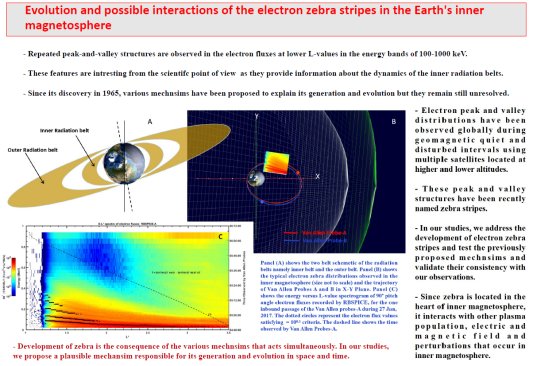関連ミッション
- ミッション3 宇宙生存環境
研究概要
The radiation belts are the regions of the Earth’s magnetosphere that mainly comprises of electrons and ions trapped below ~6 RE where the planetary magnetic field is approximately dipolar. The energy range of trapped population ranges from about 10’s of keV to MeV. The electron population is divided into two: the outer radiation belt located at ~4–5 RE and the inner radiation belt resides mainly below 2.5 RE in the equatorial plane. There exists a region of reduced MeV electron flux called “slot” that separates the outer electron radiation belt from an inner zone.
A periodic variations in the electron flux spectra are observed in the energy versus L-value plot for the electrons with 100’s of keV energies. The spatial distribution of these features are visible in the inner radiation belt region (L<3). The maxima and minima of these periodic variations in the electron fluxes may differ by an order or more. These features have been previously reported near the South Atlantic Anomaly region by low altitude, polar orbiting satellites. With the development of the space technology, these features were also detected by high altitude satellites and have been named as “zebra stripes” structure. The formation of such structures requires some global mechanism as it can be seen across all the MLTs in L<3 during quiet as well as disturbed intervals. Several studies have already proposed the plausible mechanism for the observed zebra for a single event or statistically good number of events. Yet, the physics of generation of zebra is unresolved in terms of its lifetimes or characteristics variations. Hence, in the present studies, we aim to investigated the plausible sources that can affect the distribution of energetic electrons in the inner belt. We analyze energy versus L-value spectrum for the electrons in the energy range of 0.02–0.95 MeV recorded by Radiation Belt Storm Probes Ion Composition Experiment (RBSPICE) on board Van Allen Probes. A clear electron zebra distribution is observed on 27 January 2017. Figure-(C) shows the selected event with a distinct banded stripe structures of the 90° degree pitch angle distributed electron flux in the energy versus L-value spectra. The dotted lines are the electron flux values satisfying the criteria that we introduced.
The electrons with a given energy and pitch angle at a particular L-value, undergo azimuthal drift variations under the influence of electric and magnetic field of the Earth. Also, the observations of electron zebras have shown that the peak intensities decreases with the increasing L-value. Hence, the electron drift frequency along each peak of the zebra remains constant. This constancy has been observed in the form of straight line across entire globe when electron peak fluxes are plotted in drift frequency versus L-value spectrogram. Thus, a global mechanism is likely to redistribute electron patterns in the inner radiation belts. So, we trace the trajectory of electrons back in time to identify the initial location of the electron with different energies where the global mechanisms may provide a sufficient source to result in redistribution of these particles in the energy band of 0.02 to 0.6 MeV in the L-range of 1 to 2. Two major global mechanisms that could lead to the perturbations of energetic electrons down to the L<3 is (i) the disturbances due to interactions between solar wind and Earth’s magnetic field and (ii) rotation of the Earth on its own axis. In our studies, we provide the comprehensive idea of the plausible global mechanism for the formation and evolution of electron zebra stripes upto L<3.
ページ先頭へもどる
2022年2月22日作成



